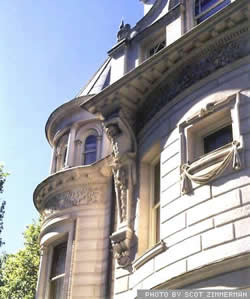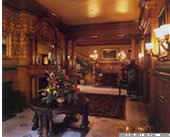Fire, Smoke and Repairs
On December 15, 1993, fire swept through the stately Utah Governor’s Mansion. The cause: faulty wiring on the Christmas tree in the Grand Hall.

Smoke traveled quickly from the hall to the nearby stairwell, which channeled heat and smoke up through the house and out the roof nearly destroying the dome over the staircase.
Fortunately, the Governor’s family (Governor Leavitt was not in the mansion at the time of the fire) and staff were able to alert the fire department and escape without injury. The Salt Lake City fire department responded immediately and took special precautions to protect irreplaceable elements of the building. They placed dams across doorways to prevent water from spreading into rooms which did not have to be exposed to the fire-fighting process.
Shortly after the fire was extinguished, representatives of the State Fire Marshal’s Office, the Division of Facilities Construction and Management, and the Division of State History met to assess the damage. Utah Disaster Kleenup was called in to vacuum up water, dry out the mansion and start topical cleaning of all surfaces. A temporary heat source was placed in the building to prevent damp wood from freezing and cracking. These initial actions marked the beginning of an arduous effort to ensure the preservation and restoration of this national treasure. Enough of the mansion’s original materials remained to warrant a comprehensive restoration. What was lost in the fire was replicated to the highest possible standards, while original materials were cleaned and refinished. Delicate original plasterwork was retained in place after the plaster walls and woodwork were removed for cleaning.

Martin Churchill Associates, Inc. of Arlington, Virginia was brought in to supervise smoke and odor removal. The firm determined that virtually all interior wall surfaces would have to be removed and interior wall cavities cleaned. Sponge and grit-blasting were used to clean the interior surfaces of caustic tar, smoke and soot damage. Ozone generators were used to complete the combustion process and eliminate odors before the walls were replastered.
The most extensive exterior smoke damage occurred on the south second level porch. Poultices, soft water washes and chemical washes were tried and were mostly ineffective cleaning tools. Finally, a soft sand-blasting technique was successful. The process left no visible damage to the stone and was used only in small areas.